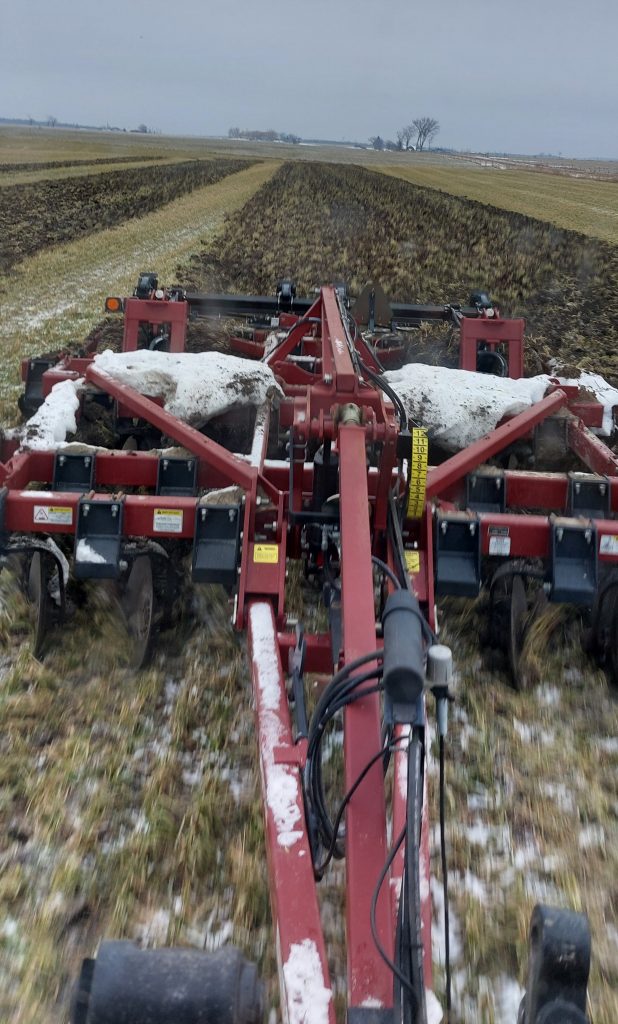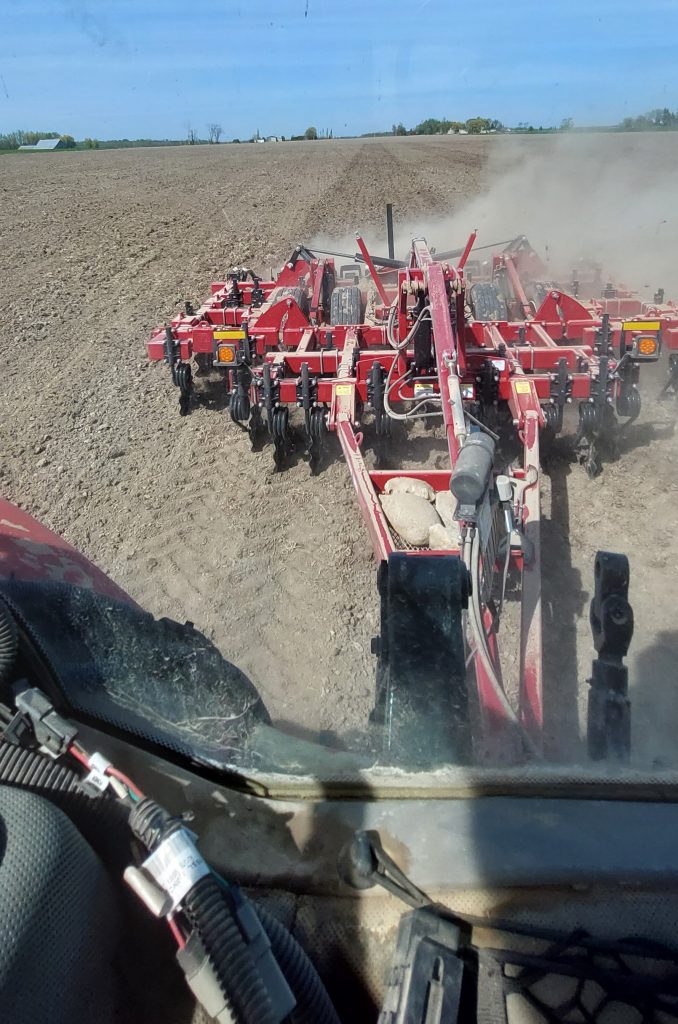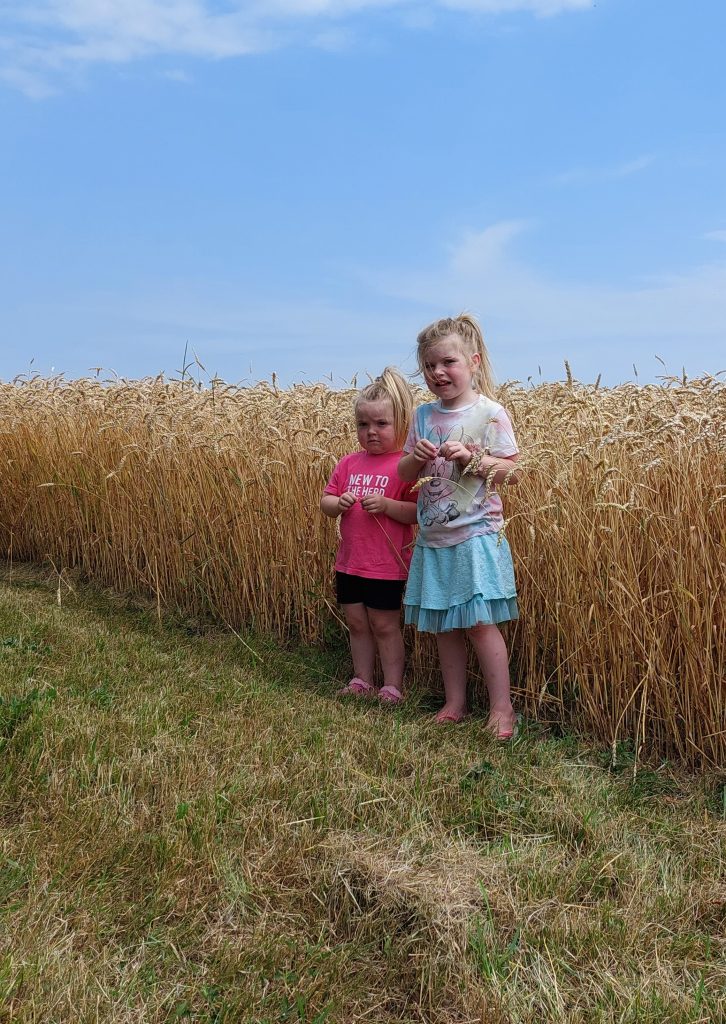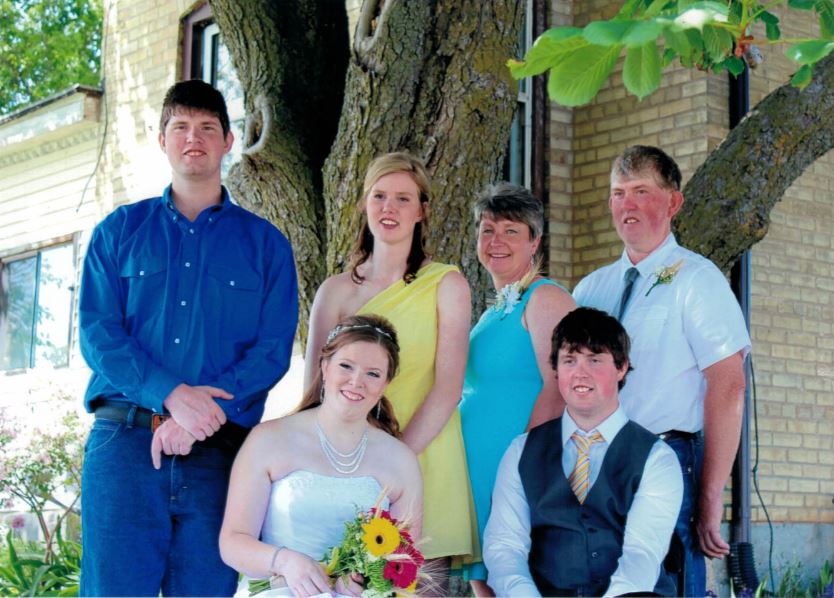
The Ribey Family. Back row left to right: Kyler, Katelynn, Pam & Terry Ribey. Front row: Kim & Kody Ribey.
Empire Cattle Co. is the home and business of Terry and Pam Ribey. Located south of Port Elgin and west of Paisley, they have been farming together for 34 years. Terry noted that he is in the 4th generation of Ribeys farming in Bruce County, his kids will be the 5th. Terry joined Bruce County SCIA in March and looks forward to learning about new practices and seeing other operations at SCIA events.
Terry’s dad Rodney farmed 100 acres in Underwood ON, where he and Terry’s grandfather raised purebred Angus cattle. Terry mentioned that Rodney was awarded recognition for 75 years of breeding registered Angus animals at the home place. This is where Terry got his start in agriculture. He worked on a dairy operation before marrying Pam and purchasing their own farm in 1990. They now own 350 acres and rent roughly 650 acres more. All their farming is done in conjunction with their three children who live and work off the farm but are heavily involved. In addition to farming, Terry has a full time grain hauling business, making runs to Hamilton and Goderich ports as well as feed mills in the area depending on demand.
Kyler is their oldest son, who works in mining, and is very handy with technical work around the farm. Kody works in construction and helps with the cattle, alongside his wife Kim (a vet tech) and their three children Hunter, Jaidyn, and Sawyer. Their daughter Katelynn works as an RPN at Parkview Manor in Chesley, will drive anything on the farm and is also a great cow person.
Terry said that when he and Pam married they started their own commercial Angus and Simmental herd and now have about 100 cow calf pairs on the farm. Forty-five or fifty of those are theirs, and the others belong to their kids.
Their cattle are rotationally grazed on 0.6 acres per day in groups of 25 or 30 cow calf pairs. They have a 30 day rest period for each pasture in the system, and altogether 50 pairs will cover about 40 acres. Pam does a lot of the cattle moving, as Terry also hauls grain full time, year round. They have a piping system to take water to the field, and portable poly troughs that service multiple paddocks and are moved every eight days using a side-by-side. Right now, they are involved in a study with the University of Waterloo which is looking at the effect of rotational versus continuous grazing practices on water quality.
Their cropping operation involves corn, soy, wheat, hay and pasture, although the boys also planted winter canola this year. He said they had it put in with an airflow planter and RTS in the fall, and before winter the crop wasn’t looking good. Since spring it has turned around and become a tremendous crop – one of the boy’s friends took a video while spraying, of a deer that was lost in the canola between leaps across the field, as the plants were so high.
Their rotation is a traditional corn, soybean and wheat one, although sometimes a field ends up rotating between corn and soybeans. They try to seed hay into their fields every four to five years as well. Terry said that they tried to incorporate cover crops for grazing into the rotation at one point, but the ground is heavy clay and it caused too much damage to the field. He joked that with a driving rain, cattle can plow a field fairly quickly!
Terry said in terms of a philosophy for their farm, they always “just try and make things better,” and that that is “just the farming way; everyone in agriculture is always trying to make things a little better, and to make the business pay”. He also feels that if a farmer can improve the ground, then benefits will be seen all around. With that in mind, he noted that they have seen yields improve on their farm from 135 bushels per acre of corn when they started, to 178, 186 and 200 bushel per acre in recent years.
One of the changes they have recently made was to apply and work in their potash in the fall, which he thinks has had a big impact on their fertility.
Another soil conservation effort on their part is to till as minimally as possible on their heavy clay ground. They don’t plow, but usually cannot no-till either. One of the best investments he thinks they’ve made is a 5100 Salford tillage unit, saying what a great job it does of working fields, not leaving any ridges or furrows at all. They use this to work fields in the fall, and then have a Salford RTS for their spring pass. Terry said the ground is too tough for no-tilling corn, but they do no-till wheat, and try to get beans in with minimum tillage.
Terry shared that Kyler and Kody have some of their own equipment as well. He said that altogether they probably have more equipment than their farm size requires, but that when everyone works off the farm as well, it’s important to have good equipment on hand at the time you need it. They used to get someone else to harvest their beans, but because the operator had to put IP beans through the machine before the Ribey’s Roundup-Ready soybeans, their crop was often harvested quite late. Having their own equipment has allowed them to time their work to the crops.
The family now uses 28% UAN on their corn and wheat, with humic acid as a nitrogen stabilizer which helps prevent volatilization from the crop. Terry also said that he adds one litre per acre of molasses to every spray application that goes on the fields. It works as a foliar application and is supposed to increase the sugars in the field and promote ‘bug health’ in the ground. He would like to introduce biologicals to their corn and soybeans, and also has tried using eco-teas as well, saying that the idea is to improve and encourage good bacteria, therefore increasing efficiency of the whole system.
Terry talked about good results seen in the USA with those sort of additives but also noted that the climate is very different there which makes it hard to know how the results might compare in Ontario. In time, he hopes that he might be able to improve biological activity enough to see a reduction in fertilizer required. So far, he has been experimenting with these applications for two years. Terry laughed, joking that the next generation are supposed to have the newer ideas, but sometimes he feels they think he’s practicing witchcraft. Anecdotally, he believes he is seeing benefits on their farm related to his experimentation.
Again in the interest of soil health, they typically plant oats or oats and peas as a cover crop after wheat. Last year they got the seed in early enough that they were able to take a cut for baleage in the fall, and then terminate the cover in the spring. He laughed remembering a year when they used turnip and oats and tried to bale it as green feed. He said the turnips sounded like stones going through the discbine, and the feed was extremely wet, but they were able to use it.
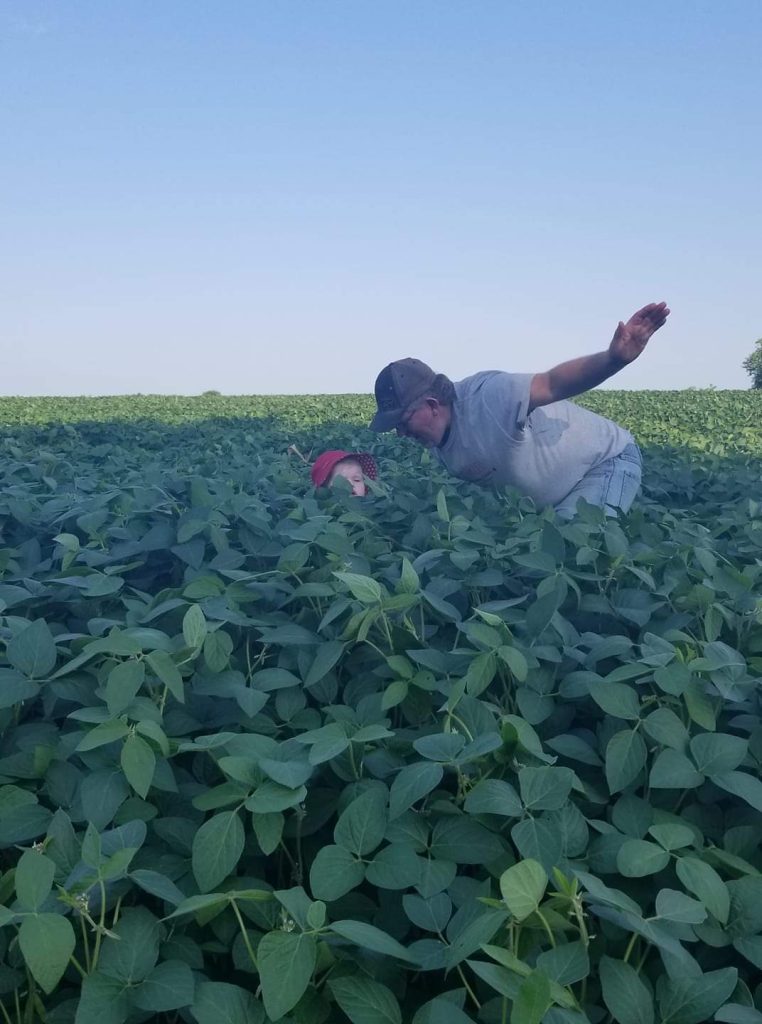
Terry checking the height of the beans with his granddaughter. His ‘Crop Barometer!’ They check the field in the same spot at the same time each year.
They have now switched all of their starter fertilizer applications to liquid and are happy with that decision. They’ve also installed precision equipment on their corn planter for population control. In the future he would like to have auto shut off on the planter as well. Their combine now has the technology to do yield mapping. At this stage they are only collecting the data, but down the road he hopes they can use the maps for variable rate application, reducing inputs and increasing efficiency. Another thing he’d like to try would be strip tilling, again with an eye to working less ground and being more efficient with their fertilizer. Terry joked he hasn’t won the ’50-million’ yet, so those plans are all for down the road.
Looking ahead, the family would always like to expand. It’s tough to compete with the really big operators for land, but in the meantime they also continue to “move things forward” and improve the ground they are on – both from an environmental and soil health perspective. Pam would like to build a new barn to improve the space for calving time, with an eye to better air and light too. Terry said that he’s waiting for their grandkids to get to be 4-H aged, as the family’s always been involved in that.
It was great to hear Terry’s enthusiasm for the farm and pride in his family as we spoke. I’d like to thank him for agreeing to an interview at such a busy time of year. We look forward to meeting at Forage Expo – July 6th 2023, which will be hosted by the Ontario Forage Council along with Bruce County Soil & Crop. It is happening across the road from the Ribey family’s farm in July and is one of the events where he hopes to network with fellow Soil & Crop members in pursuit of that goal to “make things better” – so to all the readers out there, we hope to see you there!


